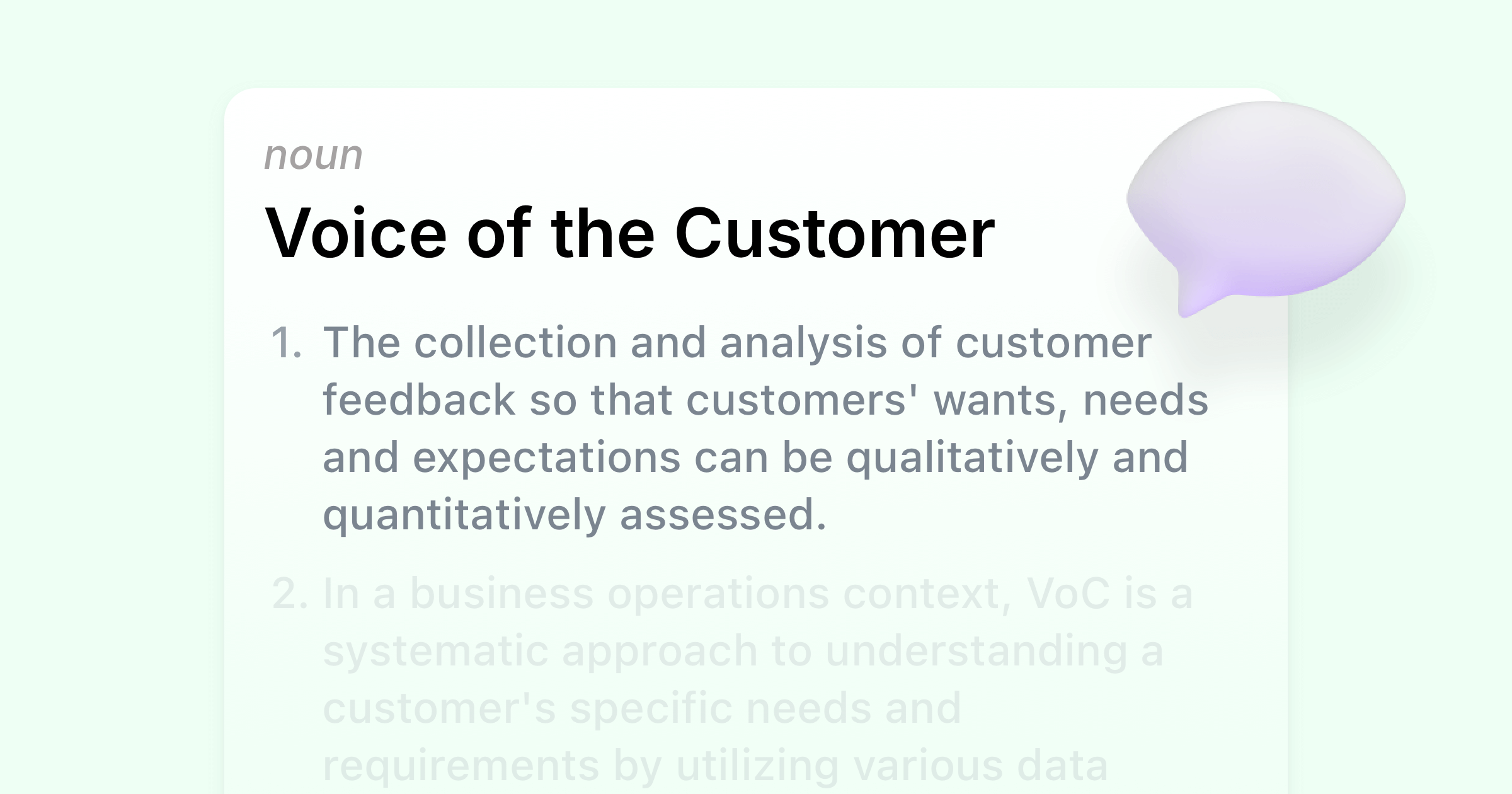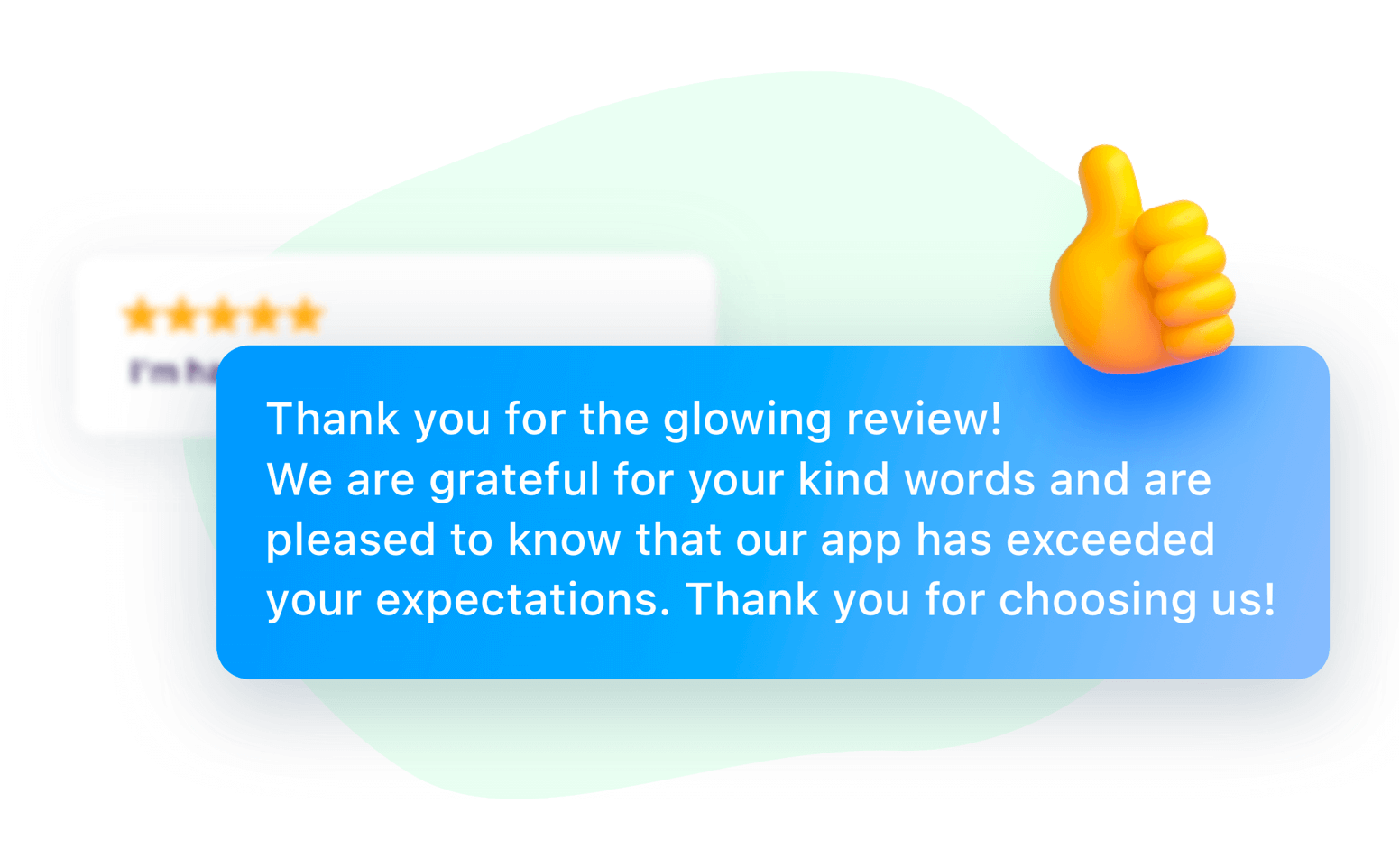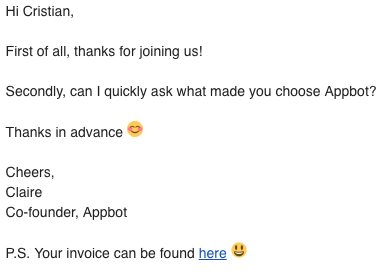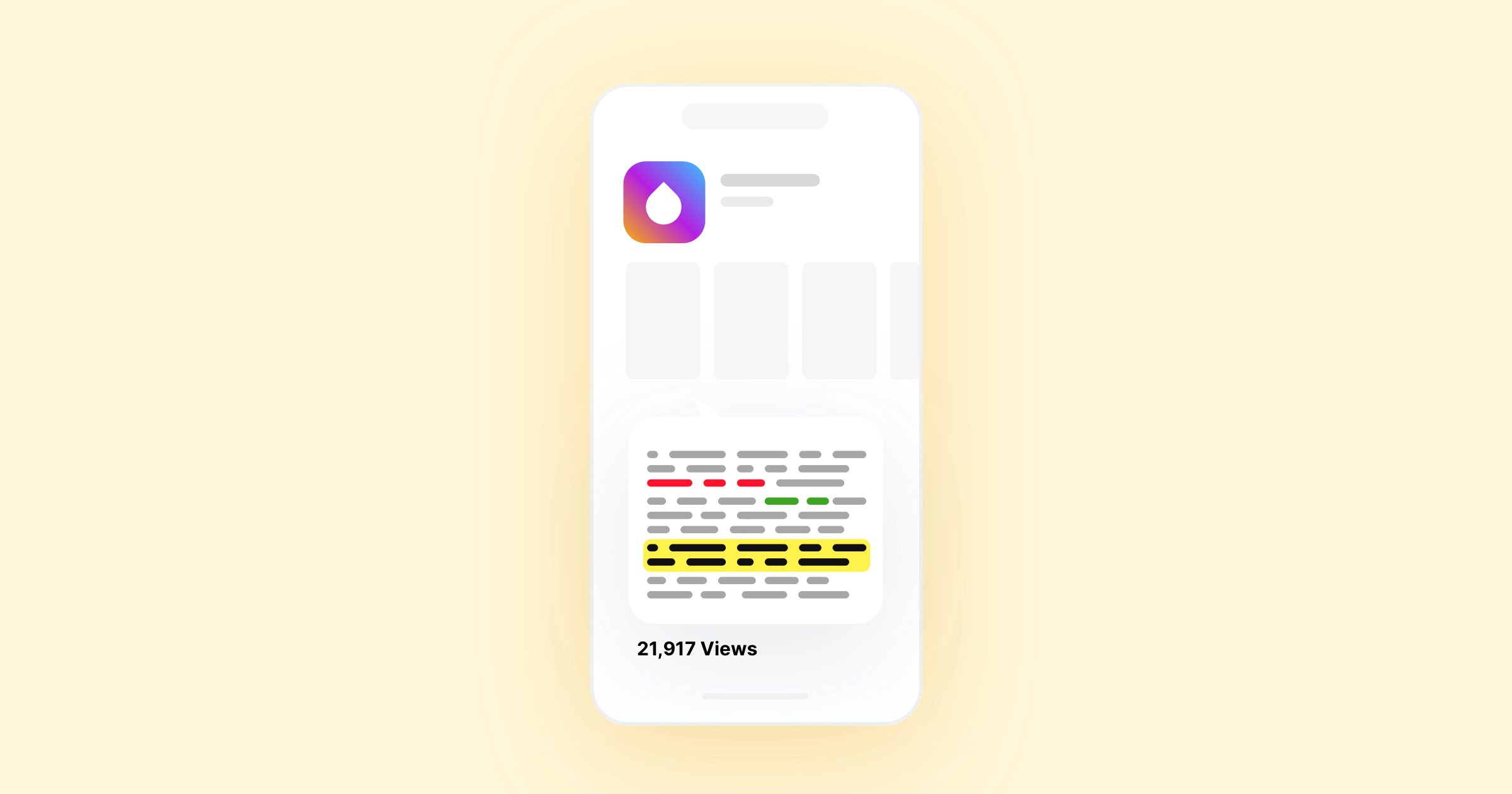Voice of the Customer: The Definitive 2024 Guide
Published 2nd February, 2024 by Claire McGregor
We wrote this guide, summarizing our decade of experience in VoC, to help you understand what Voice of the Customer is and how it can help your business to stand out in today's highly competitive landscape.
In this guide we will cover the key components of a Voice of the Customer strategy:
- What is Voice of the Customer?
- What are the benefits of Voice of the Customer?
- What types of data should you include in your VoC strategy?
- Best Practices for collecting Voice of the Customer data
Want to incorporate app reviews into your VoC strategy?
Join over 35% of the top charting app developers using Appbot to make app reviews part of their VoC strategy.
Try Appbot, free for 14 days →Never has competition in any business vertical been so fierce, or so transparent as in 2024. It's never been easier for your customers to compare your product to competitors, or for consumers to share their experiences. Today's customers share their feedback and opinions, not only with their friends and family, but with the world. Customers expect to be heard and for companies to engage with them directly wherever they are.
Today's most successful companies place the customer, their wants and needs at the centre of every decision they make. At Appbot we've been helping companies analyze their app reviews, as part of their Voice of the Customer strategy, for 10 years. Time and time again we have witnessed the huge impact that listening and responding to customers can have on your customer's experience of your product.
The migration of customer service and feedback to digital channels represents a huge opportunity for your business. With so much customer feedback available you no longer have to guess what your customers want.
Enter Voice of the Customer programs. With a coordinated effort to collect and analyze user feedback your company can improve and evolve in ways that will help you to acquire and retain your customers, and grow your revenue.
What is Voice of the Customer?

Voice of the Customer definition:
Voice of the Customer, or VoC, is defined as the collection and analysis of customer feedback so that customers' wants, needs and expectations can be qualitatively and quantitatively assessed.
Simply put, Voice of the Customer is the process of getting to know your customer and understand how you can give them a better experience.
What is a Voice of the Customer Strategy?
A Voice of the Customer strategy is a group of activities designed to facilitate the collection and analysis of customer feedback, with a specific focus on identifying opportunities to improve the customer experience.
Why is Voice of the Customer important?
Having a Voice of the Customer strategy is important because it provides a methodology for monitoring and improving your customer experience (CX) and, therefore, your user acquisition and retention rate.
Voice of the Customer programs have grown in popularity and importance in recent years for several reasons:
- It costs five to twenty-five times as much to acquire a new customer as to retain an existing one. Improvements in your customer experience lead to higher retention.
- A50% of buyers are happy to share an unsolicited recommendation.
- Prospects find a customer testimonial to be 82% more credible than any marketing material a company can produce.
In the words of Leela Srinivasan, CMO of Survey Monkey:
We are all in the feedback economy, whether we like it or not.
The goal of Voice of the Customer programs
Every business has a slightly different definition of success, and therefore the specific aims of your Voice of the Customer strategy must be tailored to meet the specific objectives of your company.
Here are some popular specific aims and outcomes of Voice of the Customer programs:
| Aim | Expected Outcome |
|---|---|
| Generate a global measure of sentiment towards your brand | Measure sentiment change (hopefully improvement!) over time |
| Identify areas where customers are most satisfied with your product | Leverage in marketing | Identify areas where customers are least satisfied with your product | Understand customer needs and wants |
| Understand how customers value your product | Optimize pricing model |
| Isolate and prioritize feature requests | Feed into product roadmap |
We recommend that Voice of the Customer program objectives should measured using customer metrics, rather than revenue metrics, although there is an obvious link between the two. This is important because it ensures that each team that is directly involved in executing the Voice of the Customer program will be able to define objectives that they can directly take responsibility for. We'll expand on this later.
What are the benefits of Voice of the Customer?

Think of your Voice of the Customer strategy as a way to monitor the pulse of user sentiment. With this concept in mind, it makes sense that a study by the Aberdeen Group identified that companies with top 20% Voice of the Customer programs enjoyed a 10X YoY increase in company revenue compared to all others.
What drives this incredible revenue uplift? A well-executed Voice of the Customer program yields a long list of interconnected benefits.
Key benefits of Voice of the Customer strategies include:
- Faster improvements in your customer experience
- Proactive reputation management
- Innovate faster than your competition
- Create brand advocates and superfans
- Improved retention
- Increased ROI on marketing
- Vastly better employee retention
Let's explore each of these in a little more depth.
Faster improvements to your customer experience
More than two-thirds of marketers responsible for CX say their companies compete mostly on the basis of CX.
2017 Gartner Customer Experience in Marketing Survey
A Voice of the Customer strategy will help your team understand the weaknesses in your products and customer service. Once you identify these weaknesses you can take action to improve in those areas, and measure the impact your actions have on customer happiness.
Proactive reputation management
A company is only as good as their customers perceive them to be.
Forbes
Voice of the Customer programs not only help companies understand how their brand is perceived, they also open up a direct discussion between companies and their customers.
A well developed Voice of the Customer program will allow you to:
- Stay abreast of feedback from customers across all channels
- Identify which feedback requires the most urgent responses and prioritize it
- Measure the effectiveness of your response, and iterate accordingly.
Think of this as a massive upgrade to the reporting most companies run via their helpdesk to measure the effectiveness of different teams and agents in handling different types of customer interactions. Voice of the Customer looks not only at your helpdesk but at your social media, online reviews, forums, discussion boards, surveys and NPS results, in-product feedback, call centre and more.
Deepening your understanding of how to best engage with your customers across all of your channels allows you to make targeted efforts to improve the customer experience in each channel, and as a whole.
Innovate faster than your competition
Voice of the Customer programs expose the top wants and needs of the target customer. More advanced Voice of the Customer programs also leverage tools like emotion analysis, sentiment analysis and natural language processing to help teams solve for the customer needs that will have the greatest impact on the company's reputation.
Incorporating Voice of the Customer data into your product roadmap will help you to future-proof your product development, by removing guesswork and inevitable human biases.
Create brand advocates and superfans
Americans typically tell 24 people about negative customer service, they only tell about 15 people about positive experiences
2012 American Express Global Customer Service Barometer
Improvements in your customer experience will generate a shift in the ratio of positive to negative feedback your company receives. As feedback becomes more positive, you should see a natural increase in new business (and retention) driven by positive word-of-mouth.
That's only a part of the opportunity here, though. A brand advocate, or superfan, is someone who is an earned and genuine fan of your company - not someone who is paid to act as an ambassador.
Brand advocates proactively share positive word-of-mouth feedback about your product, without expecting anything in return. They're typically very active on social media, forums, discussion boards and review sites, and are loyal to your company in both good times and bad. Brand advocates can be your most effective sales people, if you know how to identify and work with them.
Your Voice of the Customer strategy provides a tool that allows you to identify your superfans, so that your marketing team can begin to develop relationships with them.
Improved Retention
70% of customers will do business with you again if you resolve their complaints
Understanding Customers by Ruby Newell-Legner
The same study that we mentioned earlier by the Aberdeen Group found that companies with an effective Voice of the Customer program had 55% higher customer retention than those without.
It makes perfect sense; customers who have a great experience with a company, product or service are unlikely to shop around when it's time to re-purchase.
Companies with a well developed Voice of the Customer program not only have ever-improving customer experiences which draw their customers back, they also identify issues promptly and have systems in place to turn a negative experience into a positive one via great customer service.
Increase ROI on Marketing
89% of companies now expect to compete mostly on the basis of customer experience.
Salesforce - What is Customer Service
Voice of the Customer has a positive impact on your marketing ROI in several different ways.
Your Voice of the Customer strategy can help you increase the proportion of new business driven by word-of-mouth vs paid sources, through brand advocates. Involving brand advocates in your marketing strategy via case studies, testimonials, videos or blog posts is not only cost-effective, new prospects are more likely to trust a fellow customer.
Voice of the Customer programs also help you understand customer preferences, including the financial, social, political and environmental impacts on a customer's buying behaviour. As your understanding of these factors grows you can leverage this knowledge to optimize the 4 Ps of marketing for your product: Product, Price, Promotion and Place.
Improved employee Retention
By putting the employee first, the customer effectively comes first by default, and in the end, the shareholder comes first by default as well.
Richard Branson
Another study by the Aberdeen Group found that companies with a best-in-class Voice of the Customer program have 292% better employee engagement rates! Again, there are a few mechanisms that contribute to this positive outcome:
- Voice of the Customer programs empower employees to engage with customers directly
- Direct engagement with customers creates greater empathy
- Increased empathy with customers motivates employees to advocate for better customer outomes
- This advocacy is nurtured and rewarded by customer-centric companies.
A well designed Voice of the Customer program also aligns your employees' objectives with customer experience goals. When the customer succeeds your employee also succeeds, improving workplace satisfaction and motivation. This can materially reduce your staff turnover and increases employee productivity, leading to further improvements in customer satisfaction.
What types of data should you include in your VoC strategy?

There are dozens of ways to capture customer feedback, some solicited and some unsolicited. If we look back to our Voice of the Customer definition, we see that it's also important to include both qualitative and quantitative sources of data.
It used to be very challenging and costly to turn feedback collected from many of the sources below into meaningful data, since the feedback is largely unstructured. With the advent of Voice of the Customer platforms that incorporate sentiment analysis and natural language processing it's now possible to extract real meaning and value from unstructured customer feedback, without countless human hours spent manually reading each comment and applying a manual classification.
Think outside the box on ways to collect feedback from your customers that might enhance, rather than detract from, their experience with your company. Here are some examples to get you started:
Popular ways to capture Voice of the Customer feedback:
- App reviews & online reviews
- Social media
- Live chat
- Support tickets and emails
- Feedback and enquiry forms
- NPS surveys
- CSAT surveys
- Other on- and off-site surveys
- Forums and discussion boards
- Customer interviews
- Website behaviour
- Usability tests
- Call centre transcripts and recordings
- Focus groups
Let's look at each of those in more detail.
App reviews & online reviews
Nearly 95% of consumers use reviews and 80% of customers don't trust brands with a star rating below 4 stars. 53% of customers expect businesses to respond to negative reviews within a week, but 63% say that a business has never responded to their review.
With numbers like that both the importance of reviews and the opportunity to differentiate your CX by replying to app and online reviews seems obvious. Remember, customers also care how quickly you respond to their reviews.
Many companies already have a large body of reviews. They come in many different flavours: app reviews in mobile app stores, product reviews on e-commerce platforms, place reviews on Google or Tripadvisor and many more. Any reviews you already have can be a great starting point for your Voice of the Customer analytics, since you've already got the capture mechanism in place!
Social Media
Social Media forms a significant slice of the feedback pie for many organizations. Statistics vary a little between sources, but some sources reported that as much as 90% of US businesses were using social media in 2017! Social media platforms are inherently designed to stimulate a conversation, rather than offer a unidirectional flow of feedback. This makes them a valuable tool in your Voice of the Customer feedback arsenal.
Top examples of Social Media that you might consider inlcuding in your Voice of the Customer analysis are:
- Mentions of your company and/or products on Twitter
- Comments on your Facebook page
- Reviews on your Facebook page
- Comments on your Instagram stories
- Direct messages you receive on any Social Media platform
Live Chat
Live Chat is another feedback collection method that is inherently a two-way conversation between your company and your customer. Live Chat has a lot of potential benefits for companies aside from feedback collection, ranging from increasing sales to reducing support costs and building trust with users. E-commerce businesses seem to experience outsized benefits from using Live Chat.
Support Tickets and Emails
Support tickets and emails you receive to your support, sales and other email inboxes are another two-way conversation that can give you Voice of the Customer insights on both the customer and employee sides.
Most companies with a helpdesk tool like Zendesk or Helpscout have traditionally measured KPIs that relate to the speed of response and agent efficiency. With the advent of online Voice of the Customer tools you can now take your understanding of what's happening in your helpdesk or support email account to the next level. Monitor trends in sentiment around the features of your product, surface new feature requests, see which agents receive the most positive responses… the insights you can glean here can help you level up your customer experience, fast.
Feedback & Enquiry forms
Feedback and enquiry forms typically collect inbound enquiries from customers and prospects. Again, the data these forms collect is unstructured but can be a useful source of customer expectations, wants and needs, as these are what most such forms are designed to collect.
Monitoring the topics users mention in forms and measuring the sentiment of enquiries and feedback can result in a useful contribution to your Voice of the Customer program, which you can then leverage to refine your product roadmap.
NPS surveys
Net Promoter Score (NPS) surveys are a one-question survey used to measure customer loyalty. Customers are asked "How likely are you to recommend our company/product to a friend or colleague?" on a scale of 1-10 (where 10 is extremely likely).
The NPS score for a company or product attempts to take account of the difference in customer behaviour between loyal customers, and those who are in some way unhappy with your company or product. NPS has been claimed to correlate with revenue growth.
Most NPS surveys now also include a follow-up question designed to extract the "why" behind each customer's score with a question like "Tell us why you gave us that score." Sentiment and text analytics techniques can help you make unstructured NPS responses meaningful and actionable.
Together, the quantitative and qualitative feedback you receive in NPS surveys can make a cornerstone contribution to your Voice of the Customer program.
CSAT surveys
CSAT surveys, short for Customer Satisfaction, measure how satisfied a customer feels with a specific product or service. CSAT isn't designed to assess a customer's happiness with a brand as a whole.
CSAT surveys are typically multi-question and include collection of information such as:
- Demographics - age, gender, location etc.
- Product usage - frequency, most used features, areas of disappointment
- Satisfaction scale questions for specific features - designed to help you understand that customers broad satisfaction with things like value, pricing, customer service etc.
- Open ended questions with free (unstructured) text answers - such as "What could we do better?", or "Do you have any other comments, questions or concerns?"
Like NPS CSAT gives you both quantitative and qualitative Voice of the Customer insights.
Other on-site and off-site surveys
There are numerous other survey techniques you can use to collect feedback from customers. The variations and possibilities are almost endless, but here are a few survey types we suggest you consider incorporating into Voice of the Customer reporting:
- On-site surveys asking for feedback about a new feature
- On-site surveys within your knowledgebase, to assess the helpfulness of your support docs
- Off-site surveys (usually sent via email) as follow-ups to customer support interactions.
These can be used to gauge how effective your customer service was in each instance.
Forums & discussion boards
Many companies use an online forum or discussion board to help their customers self-serve and provide peer-to-peer support. These forums are often white-labelled using a tool like Uservoice.com and, unlike product agnostic forums such as Stack Overflow, the data collected is therefore often owned by the company the forum belongs to. Using natural language procesƒbest practsing techniques to interrogate the most popular topics mentioned or questions asked on your forum or board can really help to uncover customer wants and needs, as well as highlighting opportunities to improve your existing product or service. As your forum grows this feedback can become increasingly valuable as a data source for your Voice of the Customer program.
Customer Interviews
Customer interviews have long been used for collecting Voice of the Customer data. Interviews are generally one-to-one, either in person or via a phone or video call. This makes customer interviews one of the more costly techniques included in this list. In recent years some companies have elected to interview users by email to reduce cost and ensure the Voice of the Customer data is captured in text form, thereby lending itself to sentiment and text analysis.
Customer interviews might be conducted for a specific segment of your users, or for a randomly selected cross-section. Typically the interview will consist of a series of open-ended questions that are designed specifically to avoid leading the user to a particular answer. Conducting successful interviews without introducing your own conscious or unconscious bias is a skill, and you may find that it takes several attempts to refine your approach. Well-executed customer interviews can reveal a trove of Voice of the Customer insights, and have the added benefit of helping to build relationships with customers at the same time.
Website Behaviour
Measuring and monitoring your customers' behaviour when they engage with your website, app or other digital product is a great way of collecting unsolicited Voice of the Customer Data. Again, many companies are already collecting this data about their users and customers so behavioural analytics data can be a useful starting point for your Voice of the Customer program. Analysis of behaviour by customer persona or by cohort can reveal trends in feature popularity, highlight common points of frustration, and much more.
Incorporating usage behaviour from your knowledgebase can also be useful for Voice of the Customer, specifically when you interrogate the things customers are searching for in your knowledgebase. Most popular searches often reveal deficiencies in your customer service or product, and failed searches can help you understand where there are gaps in your product, or your documentation.
Usability Tests
The type of data you measure during usability tests overlaps somewhat with the behavioural data collected from your website or knowledgebase. There is one key difference; usability tests are a solicited form of feedback, and should therefore be analyzed and interpreted slightly differently as part of your Voice of the Customer program.
Some usability testing incorporates video of the test user engaging with your product, and this video can also capture comments or gestures that indicate frustration. Analyzing the most common points where users feel frustrated may reveal useful insights into areas where your digital customer experience could improve.
Call Centre transcripts and recordings
You can't get much closer to the Voice of the Customer than this! Call recordings and transcripts are a treasure trove of verbatim feedback. Examining the sentiment, common words and topics used by your customers is a great way to look for trends in:
- Common objections and complaints
- Popular requests
- Trends in call volume for different reasons
Analysis of call centre transcripts and recordings as part of your Voice of the Customer program can be instrumental as a training tool for customer service agents.
Focus Groups
Old skool! Focus groups have been around as a qualitative market research technique for several decades. Focus groups are small (think 8-12 people) and demographically diverse.
Once the group members have been chosen they are interviewed by a moderator to uncover their reactions, perceptions, opinions, beliefs and desires in relation to a product. Focus Groups can be a useful tool for collecting qualitative verbatim feedback, especially when used following broader, quantitative surveys where more detail is needed.
Like customer interviews, learning to ask questions in a manner that avoids leading the participants is critical to running a focus group successfully. Many companies use a third party that specializes in focus groups, rather than conducting them internally, and this can make focus groups a relatively expensive way to gather feedback.
As you incorporate focus group data into your Voice of the Customer analytics, be sure to make reference to the small sample size that a focus group represents.
Best Practices for collecting Voice of the Customer data

Collecting trustworthy customer feedback is a delicate business. In this section we'll look at best practices to help you collect reliable feedback for your Voice of the Customer program, and interpret it in context. The principles we'll discuss are aimed at helping you walk the tightrope between quality and quantity of Voice of the Customer data.
Be as human as possible
Seem obvious? Cast your mind back to the last call centre interaction you had with any company - did it feel personal and warm or scripted and mass-produced? We are willing to bet that it was the latter.
Taking a human approach in your Voice of the Customer feedback collection activities goes beyond simply adding a "Hi {{first.name}}" to the start of your outbound emails. Much has been written about the importance of personalization in marketing. Our experience is that personalization is even more critical when you are actively seeking feedback from customers. You are effectively asking your customers for a favor, so be sure to approach them in a respectful manner.
We suggest thinking about each of these aspects of your approach, before you begin a Voice of the Customer data collection activity:
- Does your approach feel genuine?
- If you were the recipient, would you feel confident that your feedback will be utilized?
- Are you respecting the user's privacy?
- Are you asking them in a way that won't interfere with their experience of your product? Be careful to avoid interrupting a workflow.
- Has the user had enough time to form an opinion on the subject of your feedback campaign?
- Are you prepared with a response for users who provide feedback? Make sure you say thanks, manners go a long way.
One of our most responded-to outbound emails at Appbot is our welcome email, sent right after a user subscribes to Appbot:

These new customers have generally just completed a 14 day trial, so they have an opinion about the strengths and weaknesses of Appbot. We get over 50% response rate to this email, and it provides a wealth of useful feedback for our Voice of the Customer program. It also creates a great opportunity to build a relationship with each new customer, right from the start.
Be mindful of sample size
Often we are torn between quality and quantity when we collect feedback for initiatives like Voice of the Customer programs. On one hand we have research techniques that will yield a statistically significant volume of feedback (ie. lots of responses), and on the other hand we have techniques that will yield customer feedback that is insightful and reliable (ie. highly detailed responses).
You ideally want to strike a balance by ensuring you collect feedback with enough detail, from enough people that you can draw some useful conclusions.
The volume of feedback, in this case the number of customers you collected Voice of the Customer data from, is called your sample size. In order to decide how large your sample needs to be you'll need to have some idea of how much results could vary. As a rule the more variation you expect in your results, the larger the sample size needed to draw a reliable conclusion. For example, you'll need a much larger data set to draw reliable conclusions from a survey with 20 multiple choice questions than you will to draw a reliable conclusion from a single "Yes/No" question survey. A statistically significant sample will therefore vary in size across your different Voice of the Customer activities.
There are mathematical formulae to calculate the sample size you'll need, if you're statistically-inclined. Zendesk published an excellent post explaining the basics of sample size calculations - we highly recommend checking it out.
When is a small sample size OK?
A sample may be considered large by one person and small by another. When we refer to a "small sample" in this guide we're talking about sample of fewer than 100 customers.
A small sample size is generally OK if:
- You are collecting feedback on something you already plan to do. The insight you get may be anecdotal, but still useful.
- You are following up with a lost client to learn why they left you.
- You are looking for leading indicators of churn in the future. In this case each response is useful, independent of the others.
You may want to consider excluding some small-sample data from your overall Voice of the Customer reporting, on occasion. However, bear in mind that if you feel that the results of a particular research exercise are likely to be misleading you should seek a larger sample rather than simply cherry-picking the data that you include and exclude in your Voice of the Customer reports.
When you set out to start a new feedback collection exercise consider the percentage of users you include in your sample that will actually respond with feedback. It is only the responses that form your sample.
We've found the following benchmarks are useful for forecasting sample size:
- When we take a broad sample, representative of our whole customer base, we usually see email open rates around 27-33% and response rates of around 15%.
- When we run targeted feedback campaigns on specific features we usually target the most and response rate of 25%.
Remember to factor in this attrition when you calculate your sample size. You'll need to approach enough customers to make sure that the volume of responses meets your target sample size.
Choosing the right sample size gets a little murkier when using a qualitative research technique, like customer interviews or focus groups. Usually a subjective approach will be used to decide on the sample size for qualitative Voice of the Customer data collection, and often the sample size will be decided as the data is collected. One way to do it is to stop collecting data once you reach saturation.
Choose a representative sample
Now that we've looked at how many people we need to collect Voice of the Customer data from we need to think about which people within our customer base we want to target.
Targeting a representative sample means you'll target a group of people from within your customer base whose characteristics represent the whole customer base as closely as possible. For example; if 46% of your whole customer base is female, you'll want to ensure that same percentage is reflected in your sample.
A representative sample allows you to extrapolate the results of your feedback analysis to assume that it represents the overall Voice of the Customer for your whole user base.
Truly representative sampling can be tricky, as there are often a lot of different characteristics to consider. Try these techniques, to keep it simple:
- Choose the 3-5 characteristics that you think will most affect the answers your customers give, and fous on ensuring your Voice of the Customer sample is representative on those characteristics (rather than dozens or hundreds of other characteristics you could potentially choose).
- Use a randomizing tool to pick a sample at random - this is known as "random sampling" rather than "representative sampling". You can also use a "systematic sampling" technique, like choosing every 10th person from the total data set to yield a fairly random sample.
Check for confirmation bias
Humans also have a natural tendency to seek data that validates our own hypotheses. This is called confirmation bias. Confirmation bias explains why two people with opposing views can see the same data set and both walk away feeling that their hypothesis is validated.
Before you begin capturing Voice of the Customer data to prove a hypothesis you have, you can use a simple "devils advocate" test to see whether your collection technique is balanced enough to avoid introducing confirmation bias. Here's how:
- Review the hypothesis you have about your customers.
- Consider what the opposite of that hypothesis would be.
- Look at the techniques you're using to collect the Voice of the Customer data you need to prove or disprove your hypothesis. Could this same data be used to prove the opposite hypothesis? If not, adapt your collection method so that it could be used to prove EITHER your original hypothesis, or its opposite.
In general, limiting confirmation bias means avoiding leading questions, as well as leading answers. If you're using a multiple choice format you'll want to ensure you make it equally easy for users to confirm or disprove your hypothesis, with the choices you offer and the order you present them in.
Choose the right channel
The channels you use to collect your Voice of the Customer data also have an impact on the type and quality of feedback you can expect. We have so many channels available now. If you read the previous section, How do you capture Voice of the Customer data?, you'll already be familiar with the mechanics as well as some of the pros and cons of each.
Using a mix of channels for your Voice of the Customer program is a wise choice. In the same way that your customers have different genders, socio-economic factors or geographies, different users will prefer different channels for communicating with you. Some will prefer face-to-face channels, others will prefer digital options. Offer both solicited (eg. in-app surveys) and unsolicited (eg. online reviews on third party sites) Voice of the Customer channels. It's important to make sure that customers who want to provide feedback have a way to do so, without waiting for you to ask.
Collecting customer feedback across several different mediums will also help you to ensure that you've collected a representative sample when you view all of your feedback in your Voice of the Customer platform.
Ask for feedback at the right time
Frequency and timing are critical when you're asking customers to provide feedback. Each company is different, and working out the best approach for your customer base will require patience and ongoing optimization. Here are some practical rules of thumb to help you maximize response rates for each Voice of the Customer activity:
- Allow customers enough time to form an opinion before soliciting Voice of the Customerfeedback.
- Ensure you are not sampling the same customers too often. At Appbot our rule of thumb is not to request feedback from the same user more than every 6 months.
- Timing is especially important for in-app feedback collection. Be courteous and make sure you request feedback at the end of a workflow, and always make it optional.
- Some customers will tolerate you making the same request for feedback more than once, but don't nag users with a prompt every time they log in.
Use incentives when appropriate
Offering an incentive for customers to provide feedback can increase response rates, but beware sacrificing quantity for quality. Some examples of incentives include offering gift cards in exchange for an online review or offering a discount in exchange for completing a survey.
Offering an incentive will introduce some bias into your Voice of the Customer data, as not all customers will be tempted by your incentive. It can also result in feedback of low quality - both because some users will try to provide the absolute minimum data required to get the incentive, and because some users will feel compelled to be more positive in their feedback because of the incentive.
If you are considering offering an incentive for customers to leave you feedback on a third party site make sure you are familiar with the third party's policy on incentives. Some sites, like Google and Yelp, have a strict "no incentive policy", and violating this policy can carry serious penalties.
In short, some brands find incentives an effective way to increase exposure and reputation, but beware the risks.
Effective Follow-ups
Last, but most definitely not least, following up with customers who have given you feedback, especially detailed feedback, is absolutely key to building trust with customers.
If customers have left you feedback on a public forum like one of the app stores, following up gives other customers confidence that their feedback is heard and (hopefully!) acted upon. There is evidence that companies that reply to user reviews, for example, received better ratings overall. It's hard to say whether that is because of the replies themselves, or because businesses that do reply to customers are probably making good use of the feedback they receive as part of their Voice of the Customer program, and are therefore improving all the time. Either way, the outcome is positive.
Thanking and acknowledging customers who provide feedback via a private channel, like email or a survey, is just as important. Personalize your replies as much as possible. In the small-sample Voice of the Customer exercises we run here at Appbot we generally reply to customers by hand, addressing each point they've shared directly.
This is an incredibly powerful tool in developing a relationship with customers. Here are some of the benefits we've experienced:
- Customers often send more detailed feedback after the follow-up
- Higher likelihood that recipients will respond to requests for feedback in future
- Drives great word-of-mouth
A personal thank you and follow up often comes as a pleasant surprise to customers. Unusual experiences tent to be memorable, and positive, memorable experiences are worthy of sharing.
Of course, there is a right and a wrong way to go about following up.
Avoid these pitfalls when you follow up with a customer:
- Being defensive,
- Templated or mass responses,
- Directing users to contact you elsewhere in order to have their feedback properly considered.
We recommend following these best practices for replying to customers in the app stores.
In summary
Creating a Voice of the Customer strategy for your company or product from scratch may feel daunting on a macro level. However, with a clear understanding of your goals, which data sources you already have and which other ones you may need to add it's possible for teams at almost any scale.
Thanks for reading!
You made it to the end, congrats! Now that you have a good handle on the basics of what Voice of the Customer is all about you might like to check out our tactical 10-step guide to implementing your VoC strategy.
We would also love to hear your feedback on our Voice of the Customer guide. Please don't hesitate to reach out. Thanks for reading!
Want to incorporate app reviews into your VoC strategy?
Join over 35% of the top charting app developers using Appbot to make app reviews part of their VoC strategy.
Try Appbot, free for 14 days →Where to from here?
- Now that you've read the Definitive Guide, learn the tactical steps to implement your Voice of the Customer strategy.
- Uncover the true sentiment: Dive into app review sentiment analysis to understand user feedback at a deeper level.
- Maximize user engagement: Combine app review insights with comprehensive app analysis to elevate mobile experience.
- Master the art of response: Learn the best practices for crafting an impactful app review reply to engage with your audience effectively.
- Boost your app's success: Navigate app store reviews and optimize app store ratings with expert insights.
About The Author

Claire is the Co-founder & Co-CEO of Appbot. Claire has been a product manager and marketer of digital products, from mobile apps to e-commerce sites and SaaS products for the past 15 years. She's led marketing teams to build multi-million dollar revenues and is passionate about growth and conversion optimization. Claire loves to work directly with the world's top app companies delivering tools to help them improve their apps. You can connect with her on LinkedIn.
Enjoying the read? You may also like these
 App store review analysis: A complete guide
App store review analysis: A complete guide The complete guide to app store review analysis to help app developers improve their app, boost their star ratings and drive higher downloads and revenue.
Whether you're launching a new app or looking to optimize an existing one, this guide will empower you to level up your app's profitability.
Master the art of mobile app growth hacking with this definitive guide. Explore 5 key areas: Market, Storytelling, Capturing the Market, Downloads & Conversions.
In this article we explore best practices used by top charting apps to get more (and better) reviews and put review feedback to good use.


